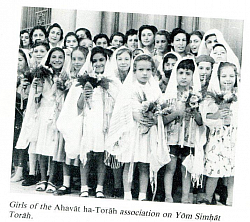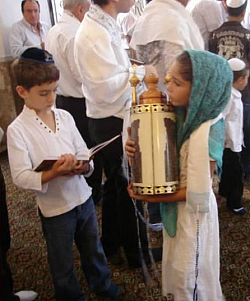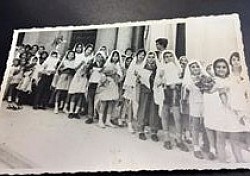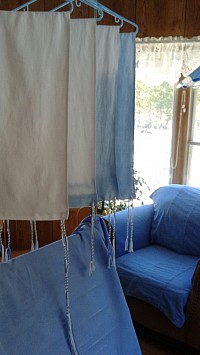Women and Sisith
There is a miswah for the children of Israel to wear sisith, but does it apply for women? I have a few different sources to consider. First there is the Torah and how the term 'the children of Israel' may be applied. Then there are at least three Karaite Hakhamim, from as early as the 10th century, who say that women are responsible to fulfil this miswah. Lastly there is a lengthy, but very informative article written about the Maharil's (R' Ya`aqov ben Moshe Lewi Moelin, 1360 - 1427), opinion against women wearing sisioth and the local rebetzin in his town, Mrs. Bruna, with her inspiring response!
From the Torah
"Speak to the Children of Israel and say to them that they are to make themselves a tassel (sisith) on the corners of their garments, throughout their generations, and are to put on the corner tassel (sisith) a thread of blue-violet. It shall be for you a tassel (sisith), that you may look at it and keep-in-mind all the commandments of YHWH and observe them, that you not go scouting-around after your heart, after your eyes which you go whoring after; in order that you may keep-in-mind and observe all my commandments, and (so) be holy to your Elohim! I am YHWH, your Elohim, who took you out of the land of Egypt, to be to you an Elohim; I am YHWH, your Elohim!"
It is also reiterated in Debarim/Deut. 22:12, (Schocken);
"Twisted-cords you are to make yourself on the four corners of your tunic-covering with which you cover yourself."
In the past, some Karaites have viewed this miswah to be for everyone. The above photos are depictions of this. A reasoning can be made that the term 'children of Israel' may include all of the people of Israel. Shabbat is a good example of when the statement, 'the children of Israel' refers to all of the men, women and children.
Wayiqra/Lev. 23:2-3, (Schocken);
"Speak to the Children of Israel and say to them: The appointed-times of YHWH, which you are to proclaim to them (as) proclamations of holiness- these are they, my appointed-times: For six days may work be done, but on the seventh day (is) Shabbath, Shabbath-ceasing, a proclamation of holiness, any-kind of work you are not to do. It is a Shabbath to YHWH, throughout all your settlements."
Karaite Hakhamim's thoughts
There are at least three Karaite Hakhamim who have stated that they believe that women are obliged to do this miswah. From Shawn Lichaa's blog 'A Blue Thread'; here
"The earliest Karaite source of which I am aware to discuss this topic was Hakham Yaqub al-Qirqisani, who lived in the first half of the 10th century. He wrote Qitab al Anwar w’al Maraqib (“The Book of Lights and Watchtowers”), his magnum opus, in Judeo-Arabic; and Professor Leon Nemoy (Z”L, pbuh) transcribed the work by hand into Arabic. According to Nemoy’s rendition, Qirqisani held that women are obligated to wear tzitzit."
Shawn continues with, "The pertinent part of sentence 4 says, “I inform that the reason for the command to wear it is: ‘…and remember all the commandments of the Lord and do them (Num 15:39)’. So out of this it is obligatory to be worn by everyone of the women and men since all of them are obliged to remember G-d’s obligations and do them and this is different from he who says that it is obligated on men and not women.” (Translation adapted from Acting Rav Joe Pessah.)"
"Qirqisani was not the only Karaite Sage who held that women must also wear blue fringes. According to Mikdash Me’at, late 10th/early 11th century Karaite Sage Levi ben Yefet also held that women must wear tzitzit. And Hakham Moshe Firrouz recently informed me that 12th century Karaite Sage Yehudah Hadassi also held that women must wear blue fringes. [2.]"
There is a foot note in the document from Hadassi that is translated by Zvi Zikhri as the following;
“Tying it, since also a daughter of Israel is of the Children of Israel, similarly as in the Ṣiṣit commandment: a commanding voice 'Speak to the Children of Israel and say to them that they shall make themselves tassels: His commandment's sanctity [spans] also the woman in keeping all the commandments, as written 'that you may look at it and keep-in-mind all the commandments of YHWH and observe them' as an obligatory command: "its insinuation as is written assemble the people" the men and women and the little-ones and your sojourner that is in your gates: its lining 'in order that they may hearken, in order that they may learn and have-awe-for YHWH your God, to carefully observe all the words of this Instruction, your Torah':"
My interview with A Blue Thread, by Shawn Lichaa
The Maharil's Opinion and Mistress Bruna's Response
By Zvi Zikhri, from his group North American Association of Qaraim Face Book page and reprinted with permission. I hope you enjoy Mistress Bruna's reponse at the end!
Blessed be YHWH for evermore ~
Since some Rabbinic Jews and Jewesses are present here -- or at least some with Rabbinic inclinations -- I wish this forum to benefit from a righteous pious Rabbinic Jewess's rebuttal to the infuriating position of the Maharil (R' Ya`aqov ben Moshe Lewi Moelin, 1360 - 1427), the leader of German Jewry in his day and known for his codification of German Jewish customs, the first rabbi ever to denounce the practice of women wearing sisiyot, whose misguided Halakhic thrust became a weighty contribution in the negative Rabbinic trend of discouraging women from wearing them.
The Maharil's Opinion
In his response there are more detailed reasonings behind this outlook
The Maharil’s comment about “arrogance” is cited by R. Yosef Karo in the "Beit Yosef" (Orah Ḥayim 17), alongside opposite opinions that permit not only the act of wearing sisit but even the blessing. He did not repeat the quotation in the Shulkan `Arukh, but R' Karo's equivalent, the Rema (R' Moshe Isserles, a main pillar of the Ashkenazic commentary. Because of these citations, the assessment of women wearing sisit as “arrogant” was popularized.
A few points here:
3. It is interesting to note that despite his firm opposition to the practice of women wearing sisit, the Maharil does not anchor his opinions in sources or present them as the result of previous Halakhic rulings, but rather explains them in terms of ideology and social consequences.
4. Despite the harshness with which he writes, he does not try to stop the woman he knows from wearing sisit because he knows she would not listen.
5. It’s surprising to learn of the existence of Bruna, the woman who wore sisit and did not give up on this miswah despite pressure from the unchallenged leader of central European Jewry, and here she kept the upper hand.
*Some questions emerging from the above (at least from a Rabbinic perspective):
1. Would it not be right to state that Rabbinic women who wear tallitot are following the Rambam’s ruling (“Women… who want to wear sisit may do so”) while those who try to stop them are violating it (“no one should interfere”)?
3. If someone chooses nonetheless to rule according to the Maharil that women should not wear sisit, should he not also rule like the Maharil by not trying to stop women who would not listen to him?
4. Today, can we really wholeheartedly accept the idea that women are not part of the bond with miswot as a whole, that miswot as a system of values belong only to men, because men are “all of one kind”? If it is forbidden to wear a tallit and Tefillin in a cemetery because it is “an act of mockery” (Berackot 18a) for the deceased who cannot, why is it permitted to wear them in front of women? Do male Orthodox Jews have compassion only for the feelings of dead people and not for the Jewish women who live among us?
5. If women really are a people in and of themselves, would it not make more sense for them, instead of following the Maharil, to follow that pious woman who refused to listen to him?
6. “Reform, Conservative, provocative, Ḥilul Hashem”.. is this not an overreaction? How did the discussion deteriorate from rationality to emotion, from Halakha to hysteria? The tendency toward hysterical and emotional reasoning is a common weakness among many Orthodox men, but here, it’s worth the effort to refrain. Exaggeration and foggy reasoning have compromised the Halakhic discourse.
7. Societal factors have always been a part of the Halakhic process. A Poseq (Rabbinic decisor) has the right to oppose women wearing tallitot, but honesty dictates two conditions: transparency and perspective. It is his responsibility to explain the facts of the case and to straightforwardly admit that this is an entirely Orthodox practice, and that Halakha permits and even encourages women to voluntarily take on miswot in which they are not obligated. That applies in particular to this extremely important miswah, which Rabbinic women have in fact practiced at different times throughout history. He could then announce that he is following the Maharil’s method and describe the contemporary circumstances that lead him to this ruling. This approach would obligate him to adhere to the measured, moderate tone that this subject demands.
8. In contemporary public Orthodox discourse, there is a common demand that women who take on this miswah should do it privately and secretly, but not in public. So far, finding a source for this demand has proved very difficult (See Shochetman and, in contrast, Lubitch Teḥumin 17). If a woman may wear a tallit, she should do so in a place of worship, including in a synagogue or at the Kotel's plaza.
9. The Women of the Wall who wear tallitot are primarily interested in them as ritual garments to be worn during prayer. If women do accept this miswah, would it obligate them to wear sisit under their clothes at all times? Not necessarily, because the necessity of sisit depends on the garment -- a person who is not wearing a four-cornered garment does not need sisit (Menaḥot 41a).
But those women would be required to put sisit on any four-cornered garments they wear during the day.
10. This gives Jewish women a rare opportunity. “The sisit that we make today are for the miswah only and are not really clothing” (Beit Yosef Oraḥ Ḥayim 17, quoting "Terumat HaDeshen"), since men no longer wear four-cornered garments. In that, we have moved away from the original miswah, in which sisit were attached to the ordinary clothing of Jewish men and women. For this reason, some great rabbis of our time have large slits made in their suit-jackets so that they will be obligated in sisit. But since women currently wear shawls and ponchos and the like, which happen to have four corners, they are uniquely positioned to return the miswah to its original glory.
Mistress Bruna's Reply!
Now here's the letter that Mistress Bruna wrote to the Maharil, in which she explains her position:
Final Thoughts
I have personally been using sisith on my prayer shawl and don this most every day. I also wear this as a scarf when attending services at the Karaite Synagogue, B'nai Israel, in Daly City, California.
I have just used white linen and sewn a rectangle scarf with a large button hole on each corner to insert a sisith. I have seen some lovely knitted and crocheted rectangular shawls made for this purpose also.





